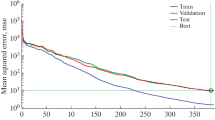Abstract
The purpose of this study is to classify 32 commercial maize hybrids with regard to grain yield stability by using an artificial neural network procedure. The hybrids were evaluated at five locations, in two late growing seasons. Each replication (R1 and R2) of the response variable was used as a network input signal to trigger the network learning process. The underlying network model has a topology consisting of two neurons in the input layer and ten neurons arranged in a two-dimensional grid. The competitive process was induced by the random presentation of an input vector \(x = [x_{1} ,x_{2} , \ldots ,x_{n} ]^{{\text{T}}}\) from the network training set, without specifying a desired output. A grid neuron y responded best to this stimulus. Thus, the neuron with the shortest Euclidean distance between the input vector and the respective weight vector \(w_{i} = [w_{i1} ,w_{i2} , \ldots ,w_{in} ]^{{\text{T}}}\), at moment t, was selected as the winner. The winning neuron indicates the center of a topological neighborhood of cooperative neurons. The adaptive process occurred via applying an adjustment Δwij to the synaptic weights wij during learning, until convergence of the network. The results showed that the classes of hybrids with the same performance pattern across environments were not altered by the network, confirming the high yield stability and satisfactory overall performance associated with higher grain yield means (above 6 t ha−1). The single-cross hybrid 10 (CD-387) stood out at all locations in both years, with unaltered data classification by the network. Therefore, it was considered to be stable in all environments, without performance variation over the years, as well as adaptable.



Similar content being viewed by others
References
Alves DP, Tomaz RS, Laurindo BS, Laurindo RD, Cruz CD, Nick C, Silva DJ (2017) Artificial neural network for prediction of the area under the disease progress curve of tomato late blight. Sci Agric 74:51–59
Braga AP, Carvalho AP, Ludemir TB (2014) Redes Neurais Artificiais: Teoria e Aplicações, 2nd edn. LTC, Rio de Janeiro
Barlow G (1989) Deficiencies and the perpetuation of power: latent functions in management appraisal. J Manag Stud 26:499–517
Barreto JM (2002) Redes Neurais Artificiais. Universidade Federal de Santa Catarina, Departamento de Engenharia Elétrica, Florianópolis
Barroso LM, Nascimento M, Nascimento AC, Silva FF, Ferreira RD (2013) Uso do método de Eberhart e Russel (1966), como informação a priori para aplicação de redes neurais artificiais e análise discriminante visando a classificação de genótipos de alfafa quanto à adaptabilidade e estabilidade fenotípica. Rev Bras Biom 31:176–188
Carvalho LP, Teodoro PE, Barroso LM, Farias FJ, Morello CD, Nascimento M (2018) Artificial neural networks classify cotton genotypes for fiber length. Crop Breed Appl Biotechnol 18:200–204
Corrar LJ, Paulo E, Dias Filho JM (2012) Análise Multivariada: para os cursos de administração, ciências contábeis e economia. FIPECAFI—Fundação Instituto de Pesquisas Contábeis, atuariais e financeiras, 1st edn. Atlas, São Paulo
Correa AM, Teodoro PE, Gonçalves M, Barroso LMA, Nascimento M, Santos A, Torres FE (2016) Adaptability and phenotypic stability of common bean genotypes through Bayesian inference. Genet Mol Res. https://doi.org/10.4238/gmr.15028260
Couto MF, Nascimento M, Amaral Júnior AT, Silva FF, Viana AP, Vivas M (2015) Eberhart and Russel´s Bayesian method in the selection of popcorn cultivars. Crop Sci 55:571–577
Cruz CD, Regazzi AJ, Carneiro PCS (2014) Modelos biométricos aplicados ao melhoramento genético, vol 2, 3rd edn. UFV, Viçosa
Eberhart SA, Russell WA (1966) Stability parameters for comparing varieties. Crop Sci 6:36–40
Erwin E, Obermayer K, Schulten K (1992) Self-organizing maps: ordering, convergence properties and energy functions. Biol Cybern 67:35–45
Gower JC (1971) A general coefficient of similarity and some of its properties. Biometrics 27:857–871
Haykin S (2001) Redes neurais: princípios e prática/Simon Haykin; tradução por Paulo Martins Engel, 2nd edn. Bookman, Porto Alegre
IPNNL (2010) NuClass 7.1. Software neural network non linear
Kohonen T (1982) Self-organized formation of topologically correct feature maps. Biol Cybern 43:59–69
Kohonen T (1989) Self-organization and associative memory, 3rd edn. Springer, Berlin
Kohonen T (1997) Exploration of very large databases by self-organizing maps. In: International conference on neural networks, vol 1, Houston, pp PL1–PL6
Lo Z, Yu Y, Bavarian B (1993) Analysis of the convergence properties of topology preserving neural networks. IEEE Trans Neural Netw 4:207–220
Ludwig O Jr, Costa EMM (2007) Redes Neurais: Fundamentos e Aplicações. Editora Ciência Moderna Ltda, Rio de Janeiro
Mitchell T (1997) Machine learning. WCB/McGrall-Hill-Computer Science Series, Boston
Nascimento M, Peternelli LA, Cruz CD, Nascimento ACC, Ferreira RP, Bhering LL, Salgado CC (2013) Artificial neural networks for adaptability and stability evaluation in alfalfa genotypes. Crop Breed Appl Biotechnol 13:152–156
Oda MC, Sediyama T, Matsuo E, Nascimento M, Cruz CD (2019) Stability and adaptability of soybean production through traditional methodologies and artificial neural networks. Sci Agrar Parana 18:117–124
Ritter H, Martinetz T, Schulten K (1992) Neural computation and self-organizing maps: an introduction. Addison-Wesley, Boston
Sant'anna IC, Tomaz RS, Silva GN, Nascimento M, Bhering LL, Cruz CD (2015) Superiority of artificial neural networks for a genetic classification procedure. Genet Mol Res 14:9898–9906
Silva GN, Tomaz RS, Sant'anna IC, Carneiro VQ, Cruz CD, Nascimento M (2016) Evaluation of the efficiency of artificial neural networks for genetic value prediction. Genet Mol Res 15:1–11
Teodoro PE, Barroso LMA, Nascimento M, Torres FE, Sagrilo E, Santos A, Ribeiro LP (2015) Artificial neural networks to identify semi-prostrate cowpea genotypes with high phenotypic adaptability and stability. Pesqui Agropecu Bras 50:1054–1060
Von der Malsburg C (1973) Self-organization of orientation sensitive cells in the striate cortex. Kybernetik 14:85–100
Ward JH Jr (1963) Hierarchical grouping to optimize an objective function. J Am Stat Assoc 58:236–244
Author information
Authors and Affiliations
Corresponding author
Additional information
Publisher's Note
Springer Nature remains neutral with regard to jurisdictional claims in published maps and institutional affiliations.
Rights and permissions
About this article
Cite this article
Clovis, L.R., Scapim, C.A., Pinto, R.J.B. et al. Yield stability analysis of maize hybrids using the self-organizing map of Kohonen. Euphytica 216, 161 (2020). https://doi.org/10.1007/s10681-020-02683-x
Received:
Accepted:
Published:
DOI: https://doi.org/10.1007/s10681-020-02683-x




